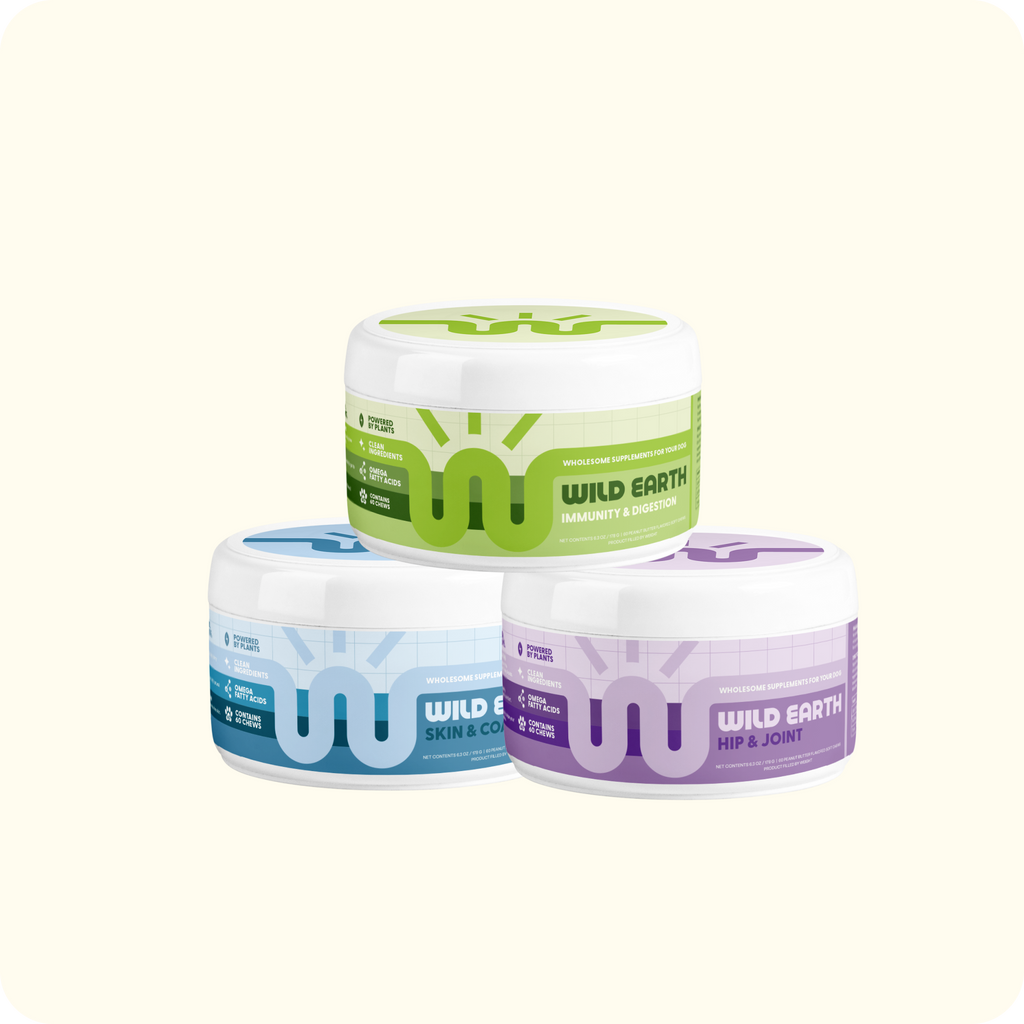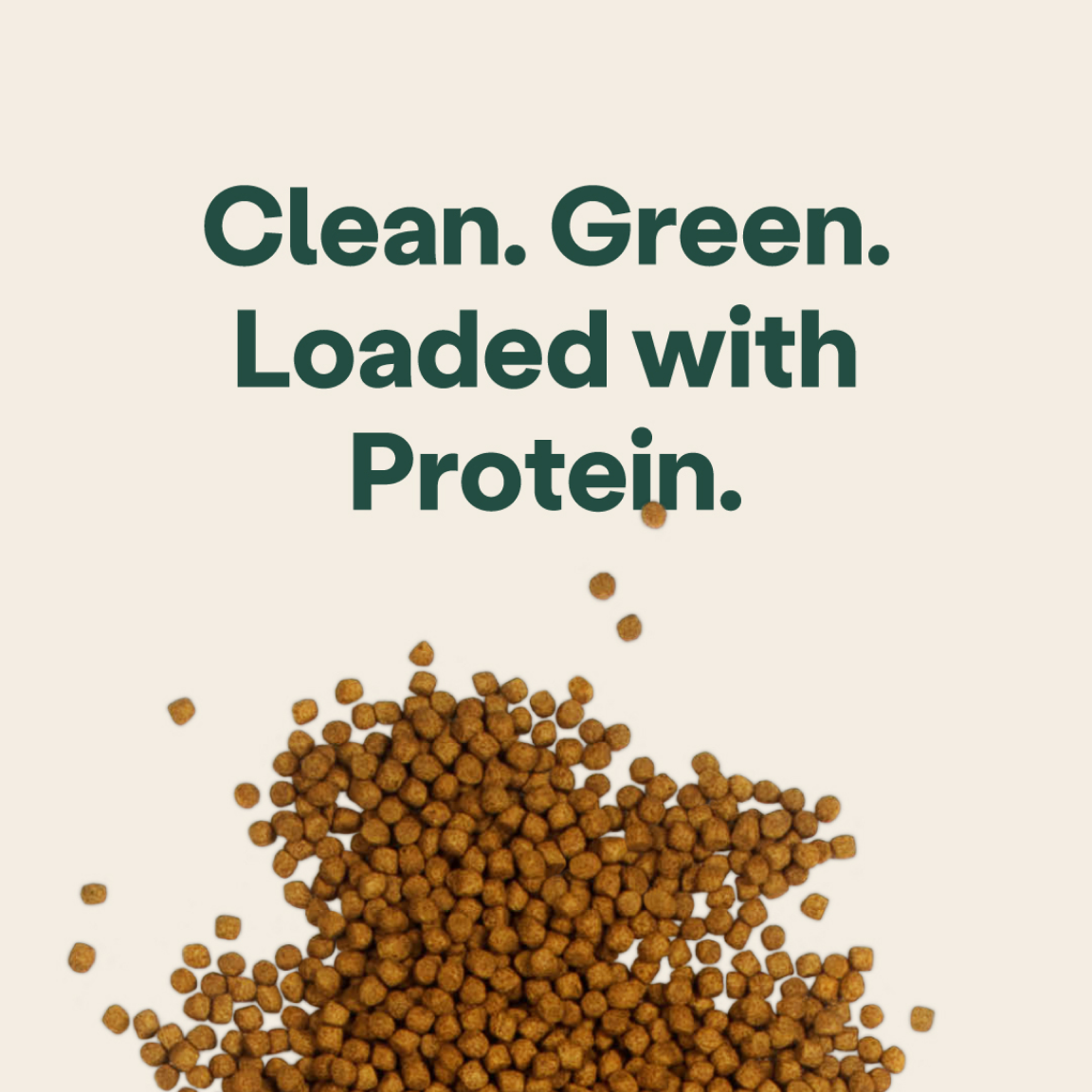
Meat-Based Diets for Dogs: The Good & The Bad
Walking through the aisles at a pet store or shopping online for dog food can seem overwhelming with choices ranging from conventional meat-based kibble, to raw meat, to plant-based. Each comes with benefits and drawbacks, but all will claim to be the best.
Feeding our pets is a way that we are able to strengthen the human-animal bond, and even better, providing our pets with food is an easy way for us to directly influence their health. In this article, I will discuss the benefits and drawbacks of meat-based kibble and raw diets, and ultimately illustrate why plant-based diets were found to be the “healthiest and least hazardous dietary choices for dogs”.2
Why do People Choose to Feed Meat
The reason meat is often a large part of a dog’s diet primarily rests on the misconception that dogs are carnivores like wolves, and therefore need animal-based ingredients to thrive. What people have failed to realize is that just because dogs have evolved from wolves, doesn’t mean they are wolves. In fact, dogs diverged from wolves over 15,000 years ago (that’s a long time ago!), and evolved alongside humans, eating their scraps which included grains, fruits, and vegetables.
During domestication, dogs gained many copies of the gene responsible for starch digestion, just as humans did during the agricultural revolution. This makes dogs more accurately classified as omnivores rather than carnivores. This means that dogs can obtain nutrients from both plant and animal matter, and therefore they can thrive on a plant-based or meat-based diet. Compared to true carnivores, dogs have lower protein and amino acid requirements and can more easily utilize vitamins A and D from plant sources, for example.
This is just one of the many myths surrounding dog nutrition, and while it is easy to access information, what is often overlooked is that it is just as easy to access misinformation. As such, it remains important to think critically when evaluating a pet food or feeding style. Let’s dive in and compare plant-based diets to traditional meat-based diets and raw meat-based diets.
What is Raw Feeding?
Raw feeding involves providing dogs with uncooked meat, bones, organs, and sometimes vegetables and fruits. Options for feeding include home preparation or selecting a commercially available diet. Commercially available diets range from complete prepared diets to pre-mix diets that require consumers to add their choice of raw protein source. These diets may or may not be nutritionally complete and balanced.
Raw Meat-Based Diets: Potential Benefits
Potential Lower Risk of IBD
When compared to meat-based kibble diets, a 2021 study based on data from a questionnaire found that dogs fed a raw meat based diet (RMBD) in their postnatal period (1–6 months of age) had a lower risk of developing inflammatory bowel disease later in life, whereas those fed kibble had a higher risk.1 The authors attributed this to a change in the microbiome of RMBD-fed dogs, however these same possible alterations in the microbiome led to adverse effects in another study.
In that study, 33 dogs were fed either a “sensitive skin” meat-based kibble diet or a commercial raw food diet.4 While those fed a RMBD had several positive changes on blood work such as a lower serum cholesterol, alkaline phosphatase and glucose, they also experienced a significant decrease in folate, B12 and iron. Based on the current evidence to date, research on RMBDs does not show a clear benefit on the gut microbiome.3
Potential Anti-inflammatory Effects
Anecdotes surrounding RMBDs include that they have anti-inflammatory and/or anti-oxidative effects as they theoretically contain higher levels of antioxidants and lower levels of heterocyclic amines (HAs). HAs are produced when muscle meat is cooked at a higher temperature such as during the production of meat-based kibble diets.
Potential Other Benefits
Furthermore, those who choose RMBDs often claim that these diets are nutritionally superior and provide many benefits such as a shiner coat and improvement in energy and immunity. Unfortunately, many of these health benefit claims have not been scientifically evaluated and therefore remain unproven.
Raw Meat-Based Diets: Potential Drawbacks
Although there are anecdotes of potential benefits of raw feeding, there exist many risks associated with feeding raw diets.
Imbalanced Nutrition
Raw feeding diets are often presented as providing a more natural and balanced approach to canine nutrition. However, achieving a truly balanced diet with all the necessary nutrients in appropriate proportions can be challenging. Dogs require a precise balance of proteins, fats, carbohydrates, vitamins, and minerals to thrive. Without careful planning and expert guidance, raw feeding may result in nutritional imbalances, leading to deficiencies or excesses of essential nutrients.
Evaluation of 200 published home-prepared recipes for adult maintenance in dogs revealed a deficiency in at least one essential nutrient according to the Association of American Feed Control Officials guidelines in 95% of diets, while 83.5 percent of recipes had multiple deficiencies.4
This does not only apply to those preparing these diets at home. Upon evaluation, many commercial RMBDs have had nutritional imbalances such as incorrect calcium to phosphorus ratio.5 This is especially true for those produced by small companies avoiding synthetic nutrient supplements.
Moreover, raw feeding often involves incorporating a wide range of ingredients, such as organ meats, which can lead to excessive intake of certain nutrients. Overconsumption of certain vitamins, such as vitamin A or D, or minerals like calcium or phosphorus, can result in toxicities and adversely affect the dog's health.
Bacterial Contamination
One of the most significant concerns with raw feeding is the risk of bacterial contamination. Raw meat, including chicken, beef, and fish, can harbor harmful bacteria such as Salmonella, E. coli, and Campylobacter. In fact, prevalence rates for contamination with Salmonella in commercial RMBDs ranges from 20% to 48%, and reports of raw meat pet food containing zoonotic foodborne bacteria are increasing.6,7 While many dogs may tolerate pathogens, others succumb to illness, and some have even died due to infection with pathogens in their raw food diets.
These bacteria not only pose a threat to dogs, but can continue to be shed in the saliva and feces even if the dog consuming the raw food does not show signs of illness. This poses a risk for humans who come into contact with the dog, especially people who are young, old, pregnant or immunosuppressed.
According to a report published by Public Health England in 2017, of four individuals (one of which died) infected with multidrug-resistant (MDR) E.coli O157, three were feeding a raw commercial frozen diet to their dog.8 All were positive for shiga toxigenic E.coli, and in one case the bacteria was cultured out of the freezer. This clearly demonstrates that although freezing and freeze-drying may reduce the number of bacteria, it does not destroy all pathogens.
Risk of Choking and Injuries
Feeding dogs raw bones is a serious health risk as bones are not only choking hazards, but they can also cause severe injuries to the dog's mouth, throat, or gastrointestinal tract. Further, contrary to popular belief, bones do not protect against periodontal disease.
Increased Handling and Storage Risks
Raw feeding requires careful handling and storage practices to prevent cross-contamination and bacterial growth. Mishandling raw meat or improperly storing it can increase the risk of bacterial contamination, leading to foodborne illnesses for both the dog and its owners.
Based on overwhelming scientific evidence, The American Veterinary Medical Association and the American Animal Hospital Association oppose the unregulated feeding of raw foods and discourage “the feeding to cats and dogs of any animal-source protein that has not first been subjected to a process to eliminate pathogens, because of the risk of illness to cats and dogs, as well as humans”.9, 10
Often Contain Common Food Allergens
The most common food allergens for dogs are animal-based proteins, namely beef, dairy and chicken, and RMBDs often contain these ingredients.
Now moving on to Meat-Based Kibble…
Meat-Based Kibble: Potential Benefits
Supporting Research
As for the benefits of meat-based kibble diets, these diets have the most amount of research behind them because the largest companies in the pet food industry make mostly meat-based kibble and have the money to fund studies including feeding trials to support nutritional adequacy.
Convenience and Low Cost
These diets offer convenience to pet parents, while also usually being lower in cost when compared to both RMBDs and plant-based kibble diets.
Decreased Tartar
Proponents of feeding meat-based kibble also claim reduced dental tartar and improved gum health. While this claim is supported by research, kibble size does matter (and this likely applies to plant-based kibble diets as well). A study published in 2007 concluded that increasing the kibble size by 50% resulted in a 42% decrease in the accumulation of dental tartar.15
Meat-Based Kibble: Potential Drawbacks
Questionable Meat
Traditional meat-based kibble typically contains the parts of animals that may be unfit for human consumption, ranging from organs to those animals that are down, dead, dying, and diseased (4D). While the use of “byproducts,” the non-rendered parts of the animal other than the meat, is environmentally responsible, it adds a question mark to what is actually in the food. Essentially it is often used as a method to keep protein levels high (but not always high quality), and food production costs low.
The more problematic meat ingredients are those designated as “meal,” which are the result of rendering. Rendering is defined as “an industrial process of ex- traction by melting that converts waste animal tissue into usable materials.” In other words, it is a process by which animal parts that are often unfit for hu- man consumption (including expired meats, the 4D meats, and even animals who have drowned after a flood) are chopped up and boiled into a stew which is then dehydrated. The fat and protein portions are then removed and used as animal fat or ground up into “meal,” respectively.
Mislabeled Meat
To further compound the problem, if the general term “meat meal” is used, the animal the parts came from is not disclosed. Even if a specific animal is named on the label such as “chicken,” for example, meat is often mislabeled, meaning what is on the bag isn’t necessarily what is inside. In 2015, a Chapman University research team looked at 52 commercial pet foods, and found that 40% of those tested contained mislabeled meat products.13
Bacterial Contamination
To add to concerns surrounding meat-based dog food, meat is much more likely to become contaminated with bacteria such as Salmonella. There have been over 180 dog food recalls since 2009, and major ones from bacterial con- taminants from meat sources. In fact, 49% of all pet food recalls in the past ten years have been from pathogenic bacteria.
Euthanasia Drug Contamination
The second leading cause of pet food recalls is pentobarbital, a euthanasia drug. In 2018, the director of FDA Center for Veterinary Medicine addressed this, stating “we have reason to believe rendered products can be a source for pentobarbital”.8
Contaminants
Meat-based pet food has not only been found to contain pentobarbital, but it has also been found to contain hormones, antibiotics, and toxic amounts of heavy metals. The Clean Label Project, a national nonprofit focused on health and transparency in labeling, tested the top pet foods and found lead in some pet foods at 16 times the concentration of lead in Flint, Michigan’s tainted drinking water. They also found arsenic in concentrations of 555 times higher than the maximum contaminant level for human drinking water set by the Environmental Protection Agency.
Heterocyclic Amines
Furthermore, kibble is made using the same process used to make breakfast cereals, high heat extrusion. During this process, wet and dry ingredients are mixed together to form a dough. The dough is then cooked under high pressure and high temperature and pushed through a ma- chine to cut the kibbles. The kibble is then dried, cooled and spray coated. On the surface this process seems benign—after all, who doesn’t love cereal? However, the problem lies in what happens to the meat when it is subjected to high temperature. Heterocyclic amines are compounds formed when muscle meat is cooked at a high temperature, and have been associated with cancer in research animals when consumed in high concentrations.14 It is important to note here that while heat processing of moist or dry extruded pet foods may have a negative impact on animal tissue proteins, heat processing improves the bioavailability of some plant proteins.
Often Contain Common Food Allergens
The most common food allergens for dogs are animal-based proteins, namely beef, dairy and chicken, and RMBDs often contain these ingredients.
How Do Plant-Based Diets Compare?
Plant-based diets are inherently free of many of the risks associated with RMBDs and meat-based kibble diets described above. They are also free of the most commonly reported food allergens for dogs, making plant-based diets a great option for dogs with food allergies, and why many food-allergic dogs have experienced symptom relief on plant-based diets. Plant-based diets also offer many other benefits, and when compared directly to conventional meat-based kibble and RMBDs, a recent study found that “the pooled evidence to date indicates that the healthiest and least hazardous dietary choices for dogs are nutritionally sound plant-based diets”.2 To learn more about the benefits of plant-based diets for dogs, check out our article Plant-Based Diets for Dogs: Benefits & Drawbacks.
References:
- HemidaM,VuoriKA,MooreR,AnturaniemiJ,Hielm-BjörkmanA. Early Life Modifiable Exposures and Their Association With Owner Reported Inflammatory Bowel Disease Symptoms in Adult Dogs. Front Vet Sci. 2021 Feb 1;8:552350. doi: 10.3389/fvets.2021.552350. PMID: 33598486; PMCID: PMC7882719.
- KnightA,HuangE,RaiN,BrownH(2022)Veganversusmeat-based dog food: Guardian-reported indicators of health. PLoS ONE 17(4): e0265662. https://doi.org/10.1371/journal.pone.0265662
- Wernimont SM, Radosevich J, Jackson MI, Ephraim E, Badri DV, MacLeay JM, Jewell DE, Suchodolski JS. The Effects of Nutrition on the Gastrointestinal Microbiome of Cats and Dogs: Impact on Health and Disease. Front Microbiol. 2020 Jun 25;11:1266. doi: 10.3389/ fmicb.2020.01266. PMID: 32670224; PMCID: PMC7329990.
- Anturaniemi J, Zaldívar-López S, Savelkoul HFJ, Elo K, Hielm-Björk- man A. The Effect of Atopic Dermatitis and Diet on the Skin Transcrip- tome in Staffordshire Bull Terriers. Front Vet Sci. 2020 Oct 16;7:552251. doi: 10.3389/fvets.2020.552251. PMID: 33178726; PMCID: PMC7596200.
- StogdaleL.Oneveterinarian’sexperiencewithownerswhoarefeed- ing raw meat to their pets. Can Vet J. 2019 Jun;60(6):655-658. PMID: 31156268; PMCID: PMC6515799.
- JonesJL,WangL,CericO,NemserSM,RotsteinDS,JurkovicDA,
Rosa Y, Byrum B, Cui J, Zhang Y, Brown CA, Burnum AL, Sanchez
S, Reimschuessel R. Whole genome sequencing confirms source
of pathogens associated with bacterial foodborne illness in pets
fed raw pet food. J Vet Diagn Invest. 2019 Mar;31(2):235-240. doi: 10.1177/1040638718823046. Epub 2019 Jan 19. PMID: 30663530; PMCID: PMC6838835. - FreemanLM,ChandlerML,HamperBA,etal.Currentknowledge about the risks and benefits of raw meat-based diets for dogs and cats. J Am Vet Med Assoc 2013;243:1549– 1558.
- FDA.gov.(2022).FoodandDrugAdministration/CenterforVeteri- nary Medicine Report on the Risk from Pentobarbital in Dog Food. Retrieved January 23, 2023, from https://www.fda.gov/media/158840/ download
- Byrne, L., Aird, H., Jorgensen, F., et al. (2018) Investigation into an outbreak of Shiga toxin producing Escherichia coli, Public Health En- gland, August 2017 (No. 2018489).
- Baede VO, Broens EM, Spaninks MP, Timmerman AJ, Graveland H, Wagenaar JA, Duim B, Hordijk J. Raw pet food as a risk factor for shedding of extended-spectrum beta-lactamase-producing Enterobac- teriaceae in household cats. PLoS One. 2017 Nov 2;12(11):e0187239. doi: 10.1371/ journal.pone.0187239. PMID: 29095871; PMCID: PMC5667807.
- Wedley,A.L.,Dawson,S.,Maddox,T.W.,Coyne,K.P.,Pinchbeck,G. L., Clegg, P., Nuttall, T., Kirchner, M., & Williams, N. J. (2017). Carriage of antimicrobial resistant Escherichia coli in dogs: Prevalence, associ- ated risk factors and molecular characteristics. Veterinary Microbiolo- gy, 199, 23- 30. ISSN 0378-1135
- Schmidt, V. M., Pinchbeck, G. L., Nuttall, T., McEwan, N., Dawson, S., & Williams, N. J. (2015). Antimicrobial resistance risk factors and char- acterisation of faecal E. coli isolated from healthy Labrador retrievers in the United Kingdom. Preventive Veterinary Medicine, 19(1-2), 31-40. ISSN 0167-5877
- Okuma, Tara A. & Hellberg, Rosalee. (2015). Identification of Meat Spe- cies in Pet Foods Using a Real-time Polymerase Chain Reaction (PCR) Assay. Food Control. 50. 9–17. 10.1016/j.foodcont.2014.08.017.
- SugimuraT,WakabayashiK,NakagamaH,NagaoM.Heterocyclic amines: Mutagens/carcinogens produced during cooking of meat and fish. Cancer Sci. 2004 Apr;95(4):290-9. Doi: 10.1111/j.1349-7006.2004. tb03205.x. PMID: 15072585.
- Hennet P, Servet E, Soulard Y, Biourge V. Effect of pellet food size and polyphosphates in preventing calculus accumulation in dogs. J Vet Dent. 2007 Dec;24(4):236-9. doi: 10.1177/089875640702400405. PMID: 18309857.









































